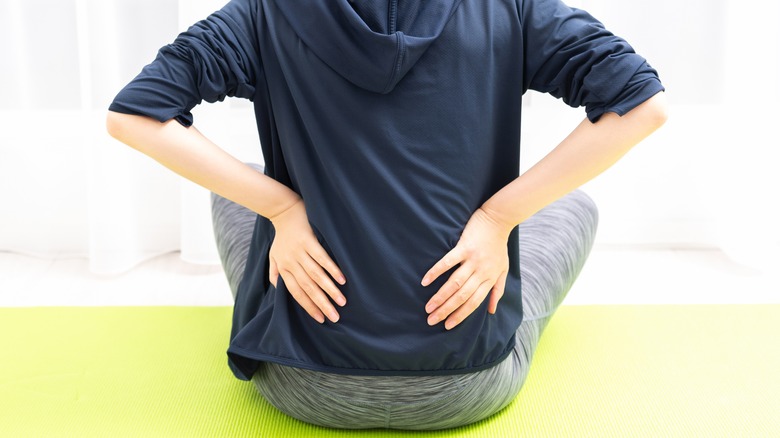Here's What It Means When You Have Trouble Kneeling
Kneeling may not have been a problem for you when you were a kid circled up on the classroom floor for storytime. If you've found that kneeling has become painful as you've gotten older, though, it may be worth taking a closer look at those kneecaps.
According to consultant knee surgeon James Newman via The Yorkshire Knee Clinic, our kneecap joint comes in direct contact with the floor while kneeling, rather than the kneecap itself. Located within this joint is where you'll find the kneecap, tendons, the infrapatellar fat pad located underneath the kneecap, and more. Connecting the kneecap, fibula, thigh, and shin bones, the knee contains a fluid-filled capsule to keep the joint lubricated (via MedicalNewsToday).
When we kneel, the pressure we place on the joint causes all of its inner parts to stretch (via The Yorkshire Knee Clinic). For those with pre-existing knee problems, doing so can worsen symptoms. While reduced flexibility is a natural part of aging, a young adult having trouble kneeling could potentially be exhibiting a sign of a medical condition or injury.
Your hips or ankles may be the problem
If you struggle to kneel, the discomfort you're experiencing may not be due to the knees at all, but rather the hips or ankles (via Livestrong). "If you have knee pain, any physical therapist will take a look at both the hips and ankles, because sometimes these joints aren't moving correctly and your knee is getting the brunt of it," physical therapist Madison Yamane told LiveStrong. Because your knee is working overtime to compensate for the tightness in your hip and ankle joints, kneeling can be especially difficult. In these cases, regular stretching can make a world of difference.
Additionally, overuse of the knee joint from excessive exercise can also make kneeling challenging. Inflammation of connecting tendons and tissues can lead to soreness and knee pain, particularly from repetitive movements where the knee joint is absorbing the majority of impact, such as jumping or downhill walking (via WebMD).
Try these sitting positions to relieve stress on the knees
In some cases, pain when kneeling may be caused by a medical condition known as bursitis, or "preacher's knee," in which the fluid-filled sacs lubricating the top of the kneecap become swollen and irritated from excessive bending (via WebMD).
While kneeling in itself is not hazardous to your health, alternate sitting positions may provide your knees with some relief. Healthline suggests sitting cross-legged, with legs straight out in front of you, or with your knees bent upwards and your legs spread wide. Similarly, bending your knees to one side while maintaining hip contact with the floor may also prove helpful. Overall, the key is to engage in a sitting position that allows you to maintain a neutral spine and relaxed shoulders in order to provide proper posture support. Be sure to change up your sitting position periodically, as remaining in one position for too long, particularly those that place continuous pressure on the legs, can reduce blood flow.



